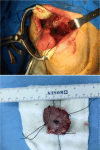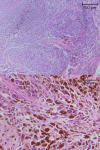Recurrent Malignant Melanoma on the Tongue: A Case Report and Review of the Literature
- PMID: 40344340
- PMCID: PMC12062517
- DOI: 10.1002/cnr2.70215
Recurrent Malignant Melanoma on the Tongue: A Case Report and Review of the Literature
Abstract
Background: Melanoma of the oral mucosa is an uncommon cancer arising from the tissues lining the mouth. Among oronasal malignant melanomas, tongue melanoma makes up a mere 2%. Optimal treatments for this rare and often late-stage disease remain elusive. However, surgery with free margins is considered the primary treatment and is often combined with other therapies such as neck dissection, adjuvant radiotherapy, chemotherapy, and immunotherapy.
Case: This case involves a 33-year-old woman with a history of malignant melanoma on her tongue. She had previously undergone a partial glossectomy and was on maintenance imatinib treatment for ~2 years. During her follow-up, a new lesion was discovered on her tongue, which was confirmed to be malignant melanoma and was resected. The tumor exhibited a depth of invasion of 8 mm. All surgical margins were clear, with the closest margin being 3 mm. The lesion was reconstructed with a submental flap. Adjuvant radiotherapy was also given. The patient has been on maintenance follow-up for 3 years with no signs of recurrence.
Conclusion: Malignant melanoma should be considered in the differential diagnosis of pigmented and non-pigmented lesions of the tongue and oral mucosa. A thorough clinical evaluation, followed by histopathological and immunohistochemical examination of any suspicious lesions, is essential for early diagnosis. Early detection and prompt treatment are crucial for optimizing patient outcomes and improving survival rates.
Keywords: mucosal melanoma; recurrent tongue melanoma; tongue malignant melanoma.
© 2025 The Author(s). Cancer Reports published by Wiley Periodicals LLC.
Conflict of interest statement
The authors declare no conflicts of interest.
Figures


Similar articles
-
[Primitive malignant melanoma of the base of the tongue].Acta Otorhinolaryngol Ital. 1996 Aug;16(4):371-4. Acta Otorhinolaryngol Ital. 1996. PMID: 9082832 Italian.
-
Primary malignant melanoma of the tongue.Chang Gung Med J. 2002 Nov;25(11):764-8. Chang Gung Med J. 2002. PMID: 12553365
-
[Primary malignant melanoma arising from the base of the tongue: a case report].HNO. 2011 Jun;59(6):588-91. doi: 10.1007/s00106-010-2233-4. HNO. 2011. PMID: 21181385 German.
-
Pigmented oral carcinoma in situ: a case report and literature review.Oral Surg Oral Med Oral Pathol Oral Radiol. 2014 Sep;118(3):e79-83. doi: 10.1016/j.oooo.2014.01.230. Epub 2014 Feb 6. Oral Surg Oral Med Oral Pathol Oral Radiol. 2014. PMID: 24746807 Review.
-
[Primary mucous membrane melanoma of the base of the tongue].Laryngorhinootologie. 1998 Apr;77(4):226-30. doi: 10.1055/s-2007-996965. Laryngorhinootologie. 1998. PMID: 9592757 Review. German.
References
Publication types
MeSH terms
LinkOut - more resources
Full Text Sources
Medical

